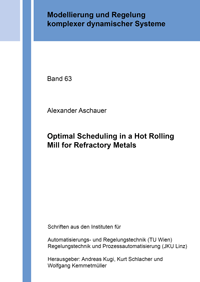
Shop : Details
Shop
Details
45,80 €ISBN 978-3-8440-9177-9Softcover128 pages20 figures188 g24 x 17 cmEnglishThesis
August 2023
Alexander Aschauer
Optimal Scheduling in a Hot Rolling Mill for Refractory Metals
The present work deals with the optimal scheduling of refractory metal products in a hot rolling mill. The scheduling problem is identified to be a so-called no-wait flexible job-shop scheduling problem with flexible processing times. It is formulated as a mixed-integer optimization problem and since this problem is NP-hard, a heuristic solution strategy is used. In fact, the overall problem is divided into a timetabling problem and a sequence optimization problem. For the timetabling, a recursive algorithm is developed, which takes into account the no-wait constraints and takes advantage of the flexible processing times. A tabu search algorithm is used for the sequence optimization.
Another focus of the work is the consideration of special constraints, i.e., release and due times, shift work, restrictions for products of the same order, and configuration changes of individual furnaces. These constraints are divided into hard and soft constraints. Violations of hard constraints are algorithmically avoided, and violations of soft constraints are taken into account by penalty terms in the cost function.
Systematic consideration of statistical information about processing times to improve the robustness of the planning result is also of interest. For this purpose, safety margins are planned during the timetabling. In the sequence optimization, tasks with high standard deviations at positions with low safety margins are penalized.
Finally, the implementation of the scheduling algorithm at the industrial plant is presented. An optimal schedule is planned based on the current plant status, the available products, and the planned work shifts.
Another focus of the work is the consideration of special constraints, i.e., release and due times, shift work, restrictions for products of the same order, and configuration changes of individual furnaces. These constraints are divided into hard and soft constraints. Violations of hard constraints are algorithmically avoided, and violations of soft constraints are taken into account by penalty terms in the cost function.
Systematic consideration of statistical information about processing times to improve the robustness of the planning result is also of interest. For this purpose, safety margins are planned during the timetabling. In the sequence optimization, tasks with high standard deviations at positions with low safety margins are penalized.
Finally, the implementation of the scheduling algorithm at the industrial plant is presented. An optimal schedule is planned based on the current plant status, the available products, and the planned work shifts.
Keywords: job shop scheduling; mixed-integer linear program; recursive timetabling; tabu search; stochastic scheduling
Modellierung und Regelung komplexer dynamischer Systeme
Edited by Univ.-Prof. Dr. Andreas Kugi (TU Wien), o. Univ.-Prof. Dr. Kurt Schlacher (JKU Linz) and Prof. Dr.-Ing. Wolfgang Kemmetmüller (TU Wien), Wien / Linz
Volume 63
Export of bibliographic data
Shaker Verlag GmbH
Am Langen Graben 15a
52353 Düren
Germany
Am Langen Graben 15a
52353 Düren
Germany
Mon. - Thurs. 8:00 a.m. to 4:00 p.m.
Fri. 8:00 a.m. to 3:00 p.m.
Fri. 8:00 a.m. to 3:00 p.m.
Contact us. We will be happy to help you.



